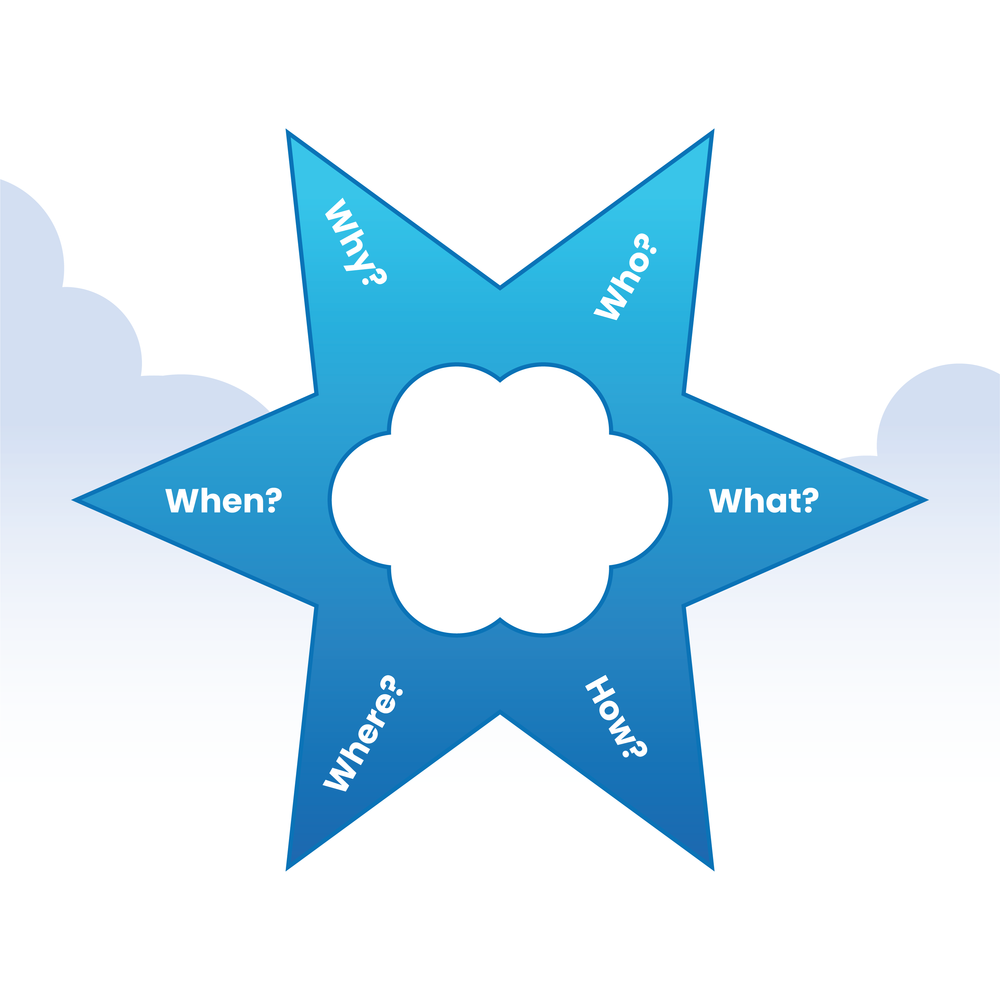Everything you need to know about starbursting

At EasyRetro, we love to inject a little fun back into the workday. Brainstorming sessions are one of the best opportunities to have fun while still making meaningful progress on a project. You’re likely aware of the more common brainstorming practices, such as brainwriting, round-robin and, mind mapping. Each form of brainstorming has its pros and cons, and choosing which to use depends on how your team operates. Today, we’ll talk about a brainstorming technique that tends to pop up a little less often, starbursting.
What is the starbursting technique?
When someone brings a new product or feature to the table, it can be easy to throw random questions out there. The problem is, random questions lead to equally random answers. “Maybe,” “No,” or “Yes, but…”
It’s hard to glean value from a conversation like that. Enter starbursting!
Starbursting is a form of brainstorming that focuses on generating questions rather than answers. It’s an iterative process that can create layers that flesh out the initial question by asking further questions.
In a starburst brainstorming session, your team will start with an idea, question, or challenge at the center and then create a six-point star around it. Each point will represent a question: who, what, when, where, why, and how.
Once you generate questions, you can break out into smaller groups and answer the questions you just generated. By the end of the meeting, you’ll have answered the core questions in a way that brings value to the product and sets the stage for the next step in the development process.
When should you use starbursting?
As with any other brainstorming technique, you can use starbursting in most situations. Starbursting shines when your team approaches something completely new, such as a new feature or a brand new product.
In the early stages of development, it’s incredibly helpful to dig to the core of the idea, and starbursting provides an excellent framework to do that. The technique allows you and your team to assess every aspect of an idea, including any potential issues that may arise during the development process.
Pros and cons of starbursting
As with everything in life, starbursting has its pros and cons that you should consider if you’re considering using the technique.
PRO: Time-saving
Because a starbursting session creates more questions rather than answers, it’s a much faster way of brainstorming ideas and features. While the session itself is quicker than standard brainstorming sessions, the team will go away to answer the questions they came up with during the session.
PRO: Exhaustive
The more questions that come out of a starbursting session, the more tracks you will have covered when you start development. Starbursting is great for getting to the very core of an idea and identifying positive aspects as well as potential downfalls.
CON: Starbursting sessions can go off the tracks easily
While starbursting seems like a simple enough concept, the constant questioning can quickly derail the meeting.
Starbursting meetings generate many different questions for each point of the star. This may seem like a lot of work at first, but the more questions you ask, the more answers you get and the more value you can put into the product.
The issue you tend to run into is that team members may start to become too specific which detrimental to the process. Others may switch off after discussing the same core question or idea for a while.
CON: Hypotheticals
As with any other brainstorming session, starbursting can bring hypothetical situations and questions into the mix. While it’s never bad to be over-prepared, it does derail the project when you start planning for unlikely situations. If you find your team gets stuck on hypothetical situations — or even worse, entirely useless ideas that bring no value to the project — consider running a prioritization session before jumping back into the starbursting session.

How to perform a starbursting session
Now that you know the ins and outs of starbursting, it’s time for you and your team to get to work!
As mentioned earlier, if left unchecked, the team can very quickly go off the rails during the starbursting session. So, it’s essential to run a starbursting session with an appointed facilitator. That way, someone is always focused on moving the meeting forward in a meaningful way and maintaining the value that this kind of brainstorming session can bring.
Don’t panic though! It’s not a tough job. Simply follow these four steps, and your team will be starbursting experts in no time!
Step 1
Use a large sheet of paper to draw a six-point star. In the middle of the star, write down your question/idea/project name.
For example, if your team is discussing a new feature that requires the user to register for an account and sign in, the center of the star will be something like, “Should we offer a range of sign-in options?”
Step 2
At each point of the star, write one of the main question groups: Who? What? When? Where? Why? And How?
Step 3
Start to brainstorm each question group and write down these questions on the relevant star point.
Remember, starbursting isn’t about answering these questions; it’s about finding questions you need to answer as the development process begins.
Looking again at the scenario we used earlier, here are some questions for each star point.
Who:
- Who will benefit from multiple sign-in options?
- Who on the team will be in charge of implementing this?
- Who else offers multiple sign-in options? (And does it help them?)
What:
- What resources do we need?
- What will different sign-in options cost us?
- What sign-in options will we support?
How:
- How will this help onboard new users?
- How will we promote it?
- How can we integrate it into our existing sign-in process?
Where:
- Where will we place the new sign-in options?
- Where the new sign-in options be advertised?
When:
- When are we looking to introduce this feature?
- When will we start developing?
- When will the advertising start?
Why:
- Why should we offer multiple sign-in options?
- Why will this make it easier to attract new users?
- Why do some of our competitors offer this feature and others don’t?
Obviously, this is a narrow subject for the sake of this example, but hopefully, this gives you a good idea of what to expect when you perform this step with your team.
Step 4
During the final stage, the team will discuss the answers to each question from the starbursting session. You then collect the responses and put them toward building a solid vision of the product or the idea.
Chances are, you’re going to come out of the session with a lot more questions than you have time to answer in one go. That’s okay! Now you have the questions that need answering, you can always host more sessions down the line.
What next?
After your starbursting session, your team is going to have a lot of questions that need answering. That leaves them with lots of decision making, prioritization, and planning to do. Luckily for you, this is what EasyRetro does best. Join us today and find out how EasyRetro can make product development easy!